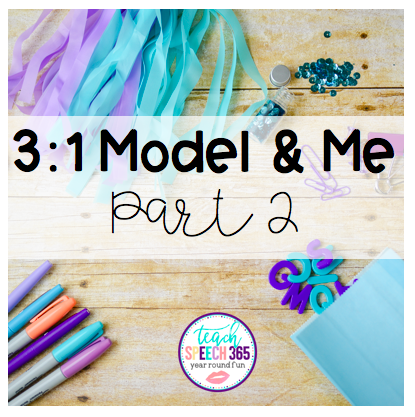3:1 Model & Me: Part 2
Back in September I blogged about how I was diving head first into the 3:1 model this year. Read Part 1 here.

I figured it would be a good idea to add a Part 2 to share how the school year went with this model. My school year doesn’t actually end for another 3.5 weeks, but close enough. I’m circling back to my pros and cons from the beginning of the year and adding some where appropriate.
Pros:
-Thus far, I’m liking the slightly longer sessions. I feel like I can get more trials and more real work done this way. As we school SLPs know, there can be some wasted time going to get kids and take them back to class. I still like the longer sessions. For a few of my students, it was a little bit of a stretch, but truthfully they didn’t notice the difference. I think the ones I really noticed it with was my preschool students. I made changes where I needed to if the 40 minutes was too long.
-I’ve explained the model to teachers and parents (I use the term “flexible scheduling”) and haven’t received any questions or negative feedback. Though I will say, I am very lucky and the majority of my teachers are very good about letting me schedule as I see fit. Same feeling. I work with amazing teachers and they rarely question me on things.
-I like knowing that I’ll have the one week to do makeups if I need to. As you know, in schools tons of events or things happen that I have no control over, which results in missed sessions. Knowing that I had the flexible week to make up sessions or schedule testing was a BIG pro. I had time to write reports and do a little bit of prep if I needed to. I don’t feel like it impacted progress and aside from some of my kids being sad that I wasn’t seeing them that week, I really loved this part.
-This week has been my first indirect week. By tomorrow, I will have tested 5 students (all with interpreters) and I’ve had time to write all the reports at work (which is huge). If I can keep scheduling the bulk of my testing during the indirect week, it will significantly cut down on the amount of therapy sessions I have to cancel. I will say I was not always able to test during the flex week. Obviously things happen. What I did like is that some of my sped teachers plan IEPs far in advance and I was able to tell them that the last week in the month was the best week because I had more flexibility.
-I actually like having the indirect week as a way to make sure my students’ skills are carrying over. When I see the student again in the new month, I can check to make sure there hasn’t been any regression which is great for determining ESY needs.
Cons:
-One major con is the loss in number of sessions I have available daily. When I used to see kids on the half hour/hour, I had 10 sessions a day. Now I only have 8 (since I need a lunch). This has resulted in me having to make groups bigger and I know once I start adding more kids, that the groups may grow even more. This ended up not being a huge issue. I did have to make a few groups bigger, but I had more time with the group so it was ok. I really don’t ever go above 4 kids in a group unless absolutely necessary.
-It is nearly impossible to ONLY have meetings during the indirect week. When I’ve had to attend meetings, they are on the hour/half hour – so I have to miss two groups most of the time. That hasn’t been too big of an issue yet, but it might become one later on as I have more and more meetings to attend. I couldn’t schedule all the meetings during the indirect week. It did affect things when meetings we scheduled on the hour or half hour, but I made it work when I had to.
-For some of my kids, particularly the ones with autism, the longer session can be more challenging. So far, I have been offering 2 breaks, whereas before I offered maybe 1, depending on the child. Same. Two breaks were needed with my more challenging students.
I definitely plan to use this model next year! Thoughts? Do you like it or want to try it? Let me know!
